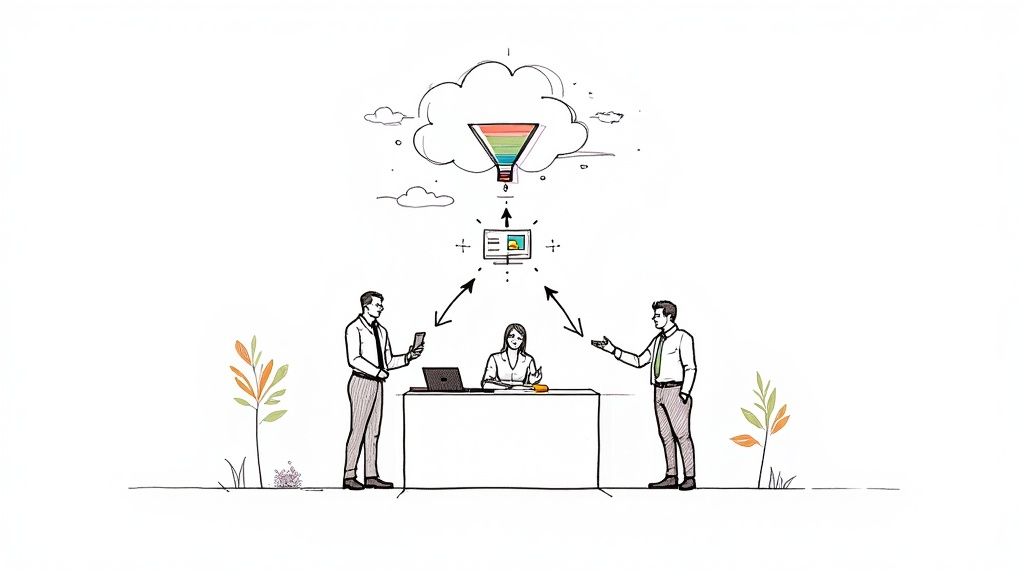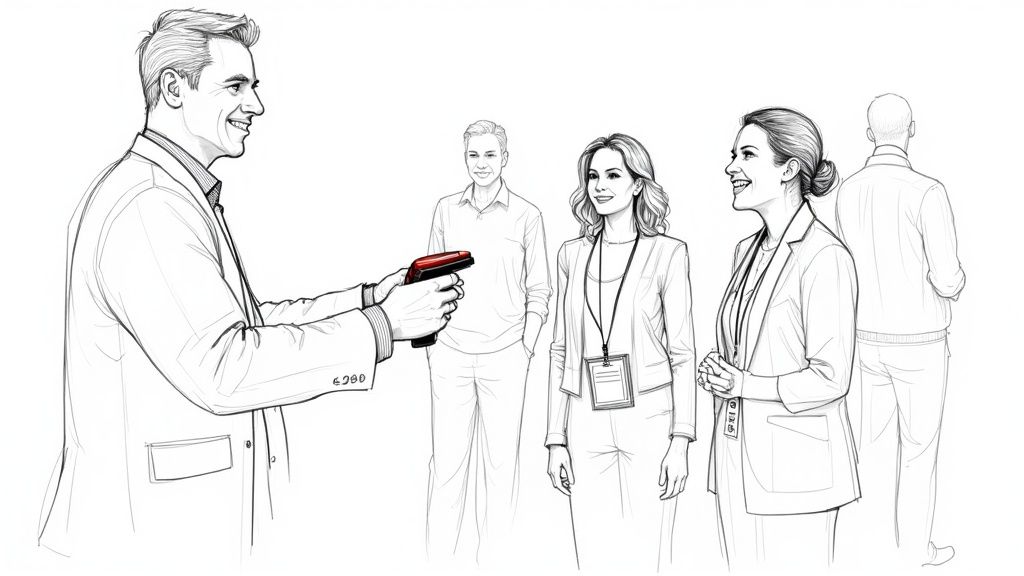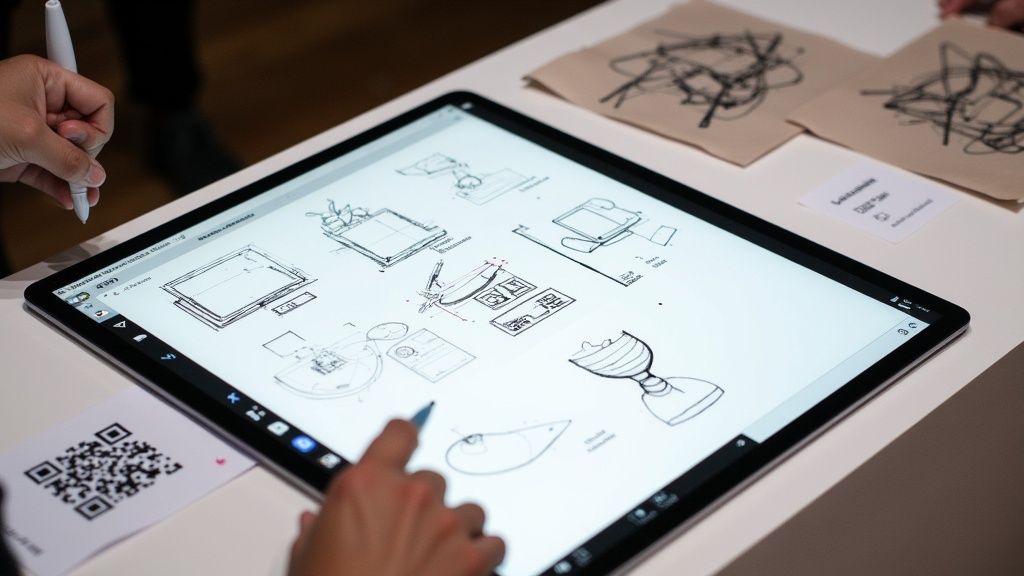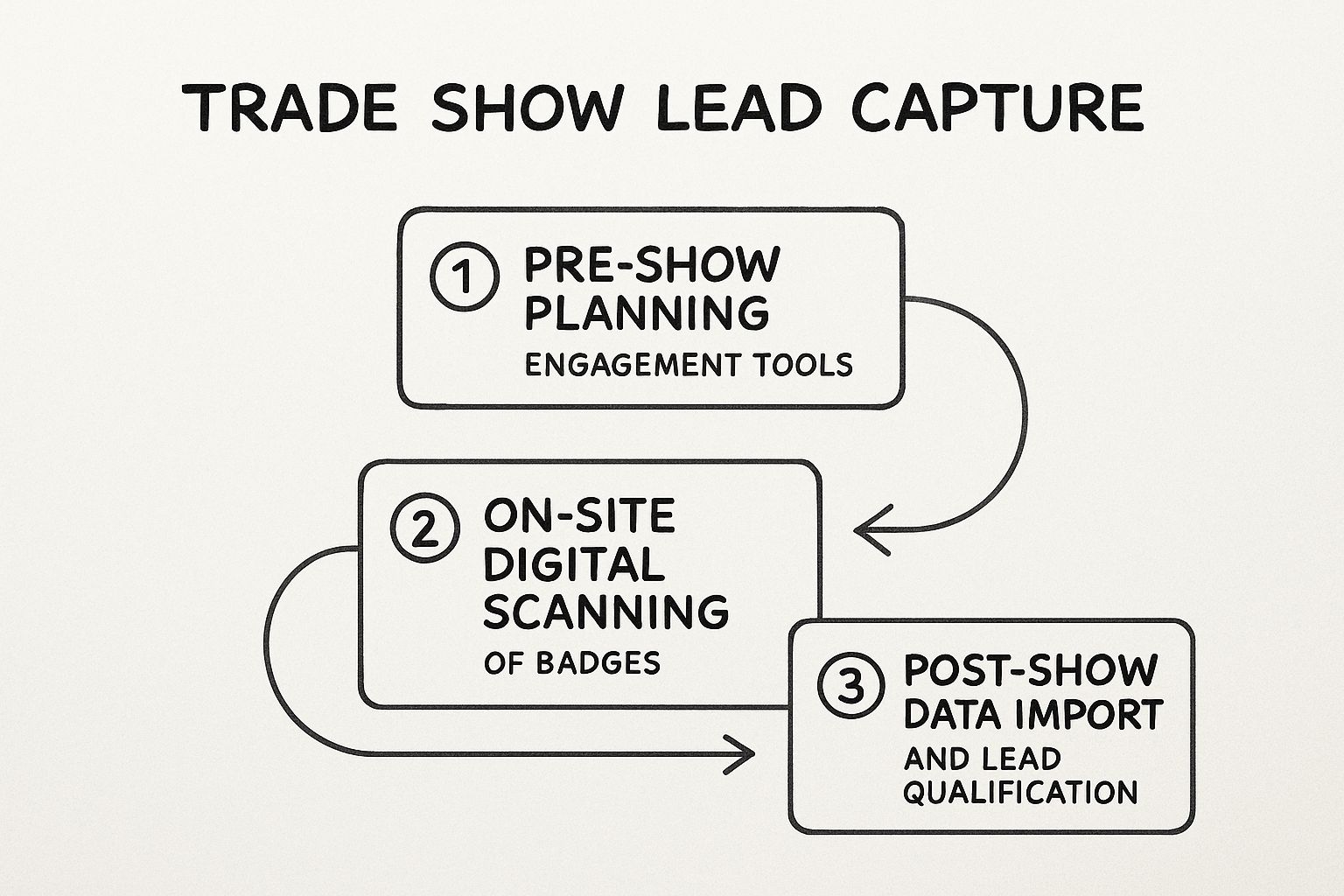July 27, 2025

When we talk about "trade show lead capture," we're really talking about the entire process of finding, qualifying, and managing potential customers on the chaotic floor of an industry event. It’s so much more than just collecting contact info. These days, it's a strategic system that starts long before the show and continues well after you've packed up the booth.

We've all seen it: the glass bowl brimming with business cards. It’s a relic of a bygone era. Honestly, it’s a passive, hope-and-a-prayer tactic in an environment that demands a proactive, strategic game plan. The gap between what companies want from trade shows and what they actually get is shocking.
Consider this: around 72% of exhibitors say their main reason for being at a trade show is to generate new leads. That's the primary goal. Yet, a tiny 6% of them actually feel confident they can turn those leads into sales. The problem gets worse after the show, with a staggering 40% of exhibitors waiting three to five days—or even longer—before they even think about following up.
The exhibitors who consistently win at trade shows have figured out a simple but powerful secret: they prioritize quality conversations over a high quantity of badge scans. They know that one genuinely interested prospect is worth a hundred names on a list.
This means you have to stop thinking of lead capture as a simple collection task. It’s a complete process that connects every part of your event strategy.
When you treat the entire event as one continuous campaign—from pre-show marketing to post-show follow-up—you build a real sales funnel, not just a spreadsheet of contacts.
The difference between the old way and the new way is night and day. It’s the difference between being passive and being purposeful. This table breaks it down.
Ultimately, a modern approach gives you control. You leave the show with a clean list of qualified leads who have already been engaged, making the handoff to your sales team smooth and effective.

The real magic of a successful trade show happens long before you set foot on the exhibition floor. It’s all in the prep work. A well-thought-out plan is what separates a booth that’s just there from one that becomes a powerful trade show lead capture machine.
It all starts with getting specific about your goals. "We want more leads" isn't a plan; it's a wish. A real plan sounds more like, "Our goal is to get 150 qualified leads" or "We need to schedule 25 demos with director-level contacts." When you set concrete, measurable targets, you give your team a clear finish line to race toward and tie your event spend directly to tangible sales goals.
Your booth staff are your front line. They're the face of your company, and their ability to connect with people is everything. They can't just be friendly badge scanners—they need to be sharp, consultative guides who can quickly pinpoint a high-potential prospect in a sea of attendees.
This means you have to arm them with the right kind of questions. The key is to shift the conversation from a generic "Can I scan your badge?" to something that uncovers a genuine business pain point.
For instance, if you're a software company, your team should be asking things like:
Questions like these do more than just qualify a lead. They collect critical intel that makes your post-show follow-up personal and ten times more effective.
The quality of your leads is a direct result of the quality of your questions. Take the time to brainstorm and role-play these conversations with your team. A sharp, well-prepared team can spot a future customer in minutes, while everyone else is just collecting business cards.
Think of your booth's layout as a tool for engagement. A welcoming, open design is crucial. It pulls people in and prevents those awkward traffic jams at the entrance that make visitors think twice about stopping by.
Where you place your trade show lead capture stations matters—a lot. Don't just stick a single check-in desk at the front and call it a day. Think strategically. Set up multiple stations: one right by your main product demo and another in a quieter nook for more in-depth chats. This setup helps you manage the flow of people and ensures you’re ready to capture a great lead wherever they happen to be in your space.
Never forget that a staggering 82% of trade show attendees have purchasing authority. Every single conversation is a high-stakes opportunity. To learn more about preparing for this powerful audience, check out this guide to effective lead capture.
Let’s be honest, the days of returning from a trade show with a fishbowl full of business cards are long gone. That old-school approach is a recipe for lost leads and painful, error-prone data entry. Your technology stack is the engine behind a modern trade show strategy, turning fleeting conversations into a smooth, automated pipeline that feeds your sales team in real-time.
You've really got two main paths to choose from. On one hand, you have dedicated, third-party lead capture apps like iCapture or fielddrive. These are the powerhouses, often packed with robust features and deep customization options. On the other hand, you have the scanners provided by the event organizers. They can be a convenient, built-in option, but they often lack the sophisticated features you need to get a real edge.
This is a great visualization of how it all should flow together, from pre-show prep to post-show nurturing.

As you can see, successful lead capture isn't just one action—it's a connected process. The tech you choose is the critical link holding everything together.
A good scanner is just the start. The real magic happens with integration. Your lead capture app should never be an island of data. Connecting it directly to your CRM, whether it's Salesforce, HubSpot, or another platform, is non-negotiable for any company serious about event ROI. This is how you eliminate manual data entry and, more importantly, trigger immediate follow-up.
Picture this:
Before that prospect has even made it to the next aisle, a personalized email hits their inbox with the exact resources they just talked about. That’s what an integrated system does. It captures the momentum of the moment, which is a massive advantage when you remember that 78% of customers buy from the company that responds first.
Connecting your on-site capture tool to your back-end sales and marketing systems isn't a luxury; it's a fundamental requirement for maximizing your event ROI. It’s the difference between a list of cold contacts and a pipeline of warm, engaged leads.
Picking the right app is about more than just a flashy feature list. You need to think about how it fits into your team's workflow and supports your overall goals. Working through these tech needs is a crucial piece of the larger event management planning process that truly sets you up for a win.
As you weigh your options, here are the things I always tell people to look for:

The show doors swing open, the crowd pours in, and all your careful planning is about to pay off. This is the moment your booth stops being a static display and becomes a living, breathing hub for connection. Forget just scanning badges—the real goal is to create an experience so engaging that people are genuinely happy to share their information with you.
On the floor, success is measured by how well you turn casual chats into rich data points. Think way beyond a name and an email. The magic happens when you capture a prospect’s intent, their level of interest, and the specific problems they’re trying to solve. That’s the fuel for a follow-up that actually works.
Let’s be honest, everyone loves a good game. Gamification is one of the best icebreakers I've seen on a trade show floor because it taps into our natural love for fun and friendly competition. A simple game can tear down that invisible wall, making the lead capture process feel less like a transaction and more like a fun exchange.
Here are a couple of ideas I’ve seen work wonders:
These aren't just gimmicks. They attract foot traffic and act as a first-pass filter. Anyone who stops to play your game is already showing more than a passing interest in what you do.
Your product demo shouldn't just be a show-and-tell. It needs to be an interactive data-gathering machine. Instead of running through a canned, one-size-fits-all presentation, design your demo to let visitors guide the experience themselves. This shifts them from passive viewers to active participants.
Imagine a software company using a large touchscreen with different user journeys. You can track exactly which features a visitor explores. Did they spend five minutes on reporting tools or click through every integration option? That’s pure intent data, and it’s absolute gold for your sales team.
The most effective booths don't just show what a product does; they create an experience that reveals what the prospect needs. Every tap, every question, and every interaction enriches the lead profile.
This shift toward interactive, tech-infused experiences is more than a fad. The whole game of trade show lead capture is changing, with smart companies using everything from AI chatbots to augmented reality (AR) product demos. You can dive deeper into the trends shaping lead generation for 2025 to see what's coming next.
Ultimately, it’s all about making every conversation a source of meaningful, actionable data. When your engagement strategy is built to capture more than just contact details, you walk away from the show with a list of truly qualified leads who are ready for a real conversation.
When the exhibit hall doors finally close, it's easy to breathe a sigh of relief. But the work isn't over—in fact, the most important part is just beginning. Every business card collected and QR code scanned represents a conversation that's quickly fading. Your ability to turn those fleeting interactions into real business depends entirely on what you do next.
This is where the real race starts. Think about it: research shows that 78% of customers buy from the very first company that responds to their inquiry. Every hour that ticks by after the show ends, the memory of your booth and your conversation gets fuzzier in your prospect's mind. Your one job is to get back in front of them while your brand is still fresh.
A follow-up sent within 24 hours of the event isn't just a suggestion; it's a competitive necessity. Wait any longer, and you're just another email in a flooded inbox from every other exhibitor who was faster on the draw.
Sending the same generic email to every single person you met is a massive missed opportunity. You didn't just collect names; you collected intelligence. Now it's time to use it. The very first thing you should do is sort your leads based on the notes your team took right there on the show floor.
Some simple, effective ways to segment your leads include:
Once you have these groups, you can stop thinking about a single email and start building a smart, multi-touch follow-up sequence that keeps the conversation going naturally.
One email is never enough. A well-planned sequence builds on the rapport you established at the booth and gently guides your prospect toward the next step.
Here’s a proven cadence you can steal and adapt:
Ultimately, a strong follow-up strategy is what separates a successful event from an expensive one. It’s how you turn a list of names into actual revenue. To get a better handle on tracking your results, you can learn more about how to measure event success and connect your post-show efforts directly to your ROI.
Even the most buttoned-up strategy runs into real-world questions on the show floor. When you're in the thick of it, practical challenges pop up. Let's dig into some of the most common hurdles I see exhibitors face and get you some straight answers to sharpen your approach for the next event.
Figuring out your return on investment can feel a little fuzzy, but it's simpler than it looks. At its core, you're just comparing what you spent to what you earned from the show.
First, you need to get ruthless about tracking your costs. Add up everything, and I mean everything, that went into the event:
Once you have that total, turn to your CRM. This is where you'll track every single lead from the event. You need to follow their journey to see how many become paying customers and, crucially, the total revenue those new deals bring in.
The classic formula is pretty direct: ((Revenue from Show Leads - Total Event Cost) / Total Event Cost) * 100. That gives you the hard ROI percentage. If you want to get more sophisticated, you can layer in Customer Lifetime Value (CLV) to see the true long-term impact of the relationships you started at that show.
Great booth training is so much more than a quick demo of the scanner app. You’re not training technicians; you’re building consultants who can represent your brand with confidence. The absolute best way to do this is with hands-on practice.
Run role-playing exercises. Seriously. Have your team practice engaging with different attendee personas—the hurried executive who has two minutes, the engineer who wants to dive deep into specs, or even a competitor sniffing around for intel.
Give them a pocket full of tools. Equip every team member with 3-5 powerful, open-ended qualifying questions that are designed to uncover a prospect's real pain points, their role in the buying process, and their timeline. It’s also incredibly effective to create a simple lead scoring system right in the app (think A, B, C or Hot, Warm, Cold). That small action on the floor makes post-show follow-up infinitely more focused and effective.
A tight budget is a constraint, not a dead end. It just means you have to be more creative than dropping a fishbowl on the counter. Forget about buying pricey hardware or getting locked into annual software contracts. Instead, look for lead capture apps that let you pay on a per-event basis.
Honestly, one of the most effective and free tools you have is a simple QR code. You can create one that links directly to a mobile-friendly lead form you built with something like Google Forms or a dedicated landing page. Attendees use their own phones to scan and input their details. This cuts out manual entry, kills transcription errors, and pipes clean data directly into your system.
At the end of the day, your most powerful low-cost tool is a disciplined follow-up process. A prompt, personal email costs nothing but time and can produce far better results than fancy tech that's poorly implemented.
Ready to manage your leads, engage your members, and measure your event ROI all in one place? GroupOS provides the all-in-one platform to turn trade show connections into a thriving community. Start your free trial today and see how easy it can be.


